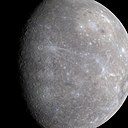Archivo:Mercury in color - Prockter07-edit1.jpg

Tamaño de esta previsualización: 600 × 600 píxeles. Otras resoluciones: 240 × 240 píxeles | 480 × 480 píxeles | 768 × 768 píxeles | 1024 × 1024 píxeles | 1950 × 1950 píxeles.
Archivo original (1950 × 1950 píxeles; tamaño de archivo: 734 kB; tipo MIME: image/jpeg)
Historial del archivo
Haz clic sobre una fecha y hora para ver el archivo tal como apareció en ese momento.
| Fecha y hora | Miniatura | Dimensiones | Apnaqiri | Comentario | |
|---|---|---|---|---|---|
| actual | 15:12 3 Mar 2008 |  | 1950 × 1950 (734 kB) | Jjron | {{Information |Description={{Information |Description=Full color image of from first MESSENGER flyby |Source=NASA/JPL [http://messenger.jhuapl.edu/gallery/sciencePhotos/image.php?page=1&gallery_id=2&image_id=143] |Date=2008-01-30 |Author=NASA/[ |
Usos del archivo
La siguiente página usa este archivo:
Uso global del archivo
Las wikis siguientes utilizan este archivo:
- Uso en ar.wikipedia.org
- المجموعة الشمسية
- عطارد
- كوكب
- بوابة:المجموعة الشمسية/مقالة متميزة
- ويكيبيديا:صور مختارة/الفضاء والكون/نظرة إلى الأعلى
- بوابة:علم الفلك/صورة مختارة
- ويكيبيديا:ترشيحات الصور المختارة/عطارد بالألوان
- ويكيبيديا:صورة اليوم المختارة/يناير 2018
- قالب:صورة اليوم المختارة/2018-01-13
- بوابة:علم الفلك/صورة مختارة/52
- بوابة:المجموعة الشمسية/مقالة متميزة/3
- ويكيبيديا:صورة اليوم المختارة/أغسطس 2021
- بوابة:كواكب
- بوابة:كواكب/كوكب مختار
- قالب:صورة اليوم المختارة/2021-08-24
- بوابة:كواكب/كوكب مختار/2
- قالب:صورة اليوم المختارة/2024-10-30
- Uso en ary.wikipedia.org
- Uso en arz.wikipedia.org
- Uso en ast.wikipedia.org
- Uso en as.wikipedia.org
- Uso en azb.wikipedia.org
- Uso en az.wikipedia.org
- Merkuri (planet)
- Planet
- Vikipediya:Həftənin seçilmiş məqaləsi/oktyabr 2016
- Vikipediya:Həftənin seçilmiş məqaləsi/42. Həftə 2016
- Portal:Günəş sistemi/Seçilmiş məqalə
- Portal:Günəş sistemi
- Vikipediya:Həftənin seçilmiş məqaləsi/sentyabr 2017
- Vikipediya:Həftənin seçilmiş məqaləsi/36. Həftə 2017
- Vikipediya:Həftənin seçilmiş məqaləsi/yanvar 2018
- Vikipediya:Həftənin seçilmiş məqaləsi/5. Həftə 2018
- Uso en ba.wikipedia.org
- Uso en bcl.wikipedia.org
- Uso en be.wikipedia.org
- Uso en bew.wikipedia.org
- Uso en bh.wikipedia.org
- Uso en bn.wikipedia.org
- Uso en btm.wikipedia.org
- Uso en ca.wikipedia.org
- Uso en ca.wikinews.org
Ver más uso global de este archivo.



